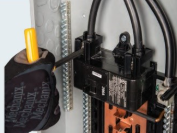How do 2023 NEC panelboard barriers improve worker safety?
| There is always a safety concern when a panelboard, switchboard, switchgear, or motor control center is opened up for maintenance while energized. It is much safer to do maintenance/additions/removals from said locations when the equipment is deenergized. There is a problem with this, however. Turning off the main breaker in a panelboard, for example, only de-energizes the load side of the breaker. The line side is still energized. Most of the time in these installations, the line-side lugs are quite prominent, and installers may inadvertently come into contact with the lugs. Because of this, Section 215.15 has been added to require barriers to be installed in certain installations. | 
|
Applying the 2023 Code
Section 215.15 has been added in the 2023 NEC to require barriers to be installed to prevent inadvertent contact by personnel during maintenance/servicing panelboards, switchboards, switchgear, or motor control centers that are supplied by feeder taps or transformer secondary conductors. This code change will provide a safer working condition for those personnel that need to service equipment that may be deenergized on the load side, but may still have energized terminals on the line side of the integral disconnecting means. Tools can inadvertently be dropped, or accidental contact can be made with such parts during the maintenance/servicing of this equipment. This new barrier requirement may pave the way for expanded barrier requirements in future editions of the NEC for all panelboards and/or disconnects.
What’s New for the 2023 NEC?
2020 NEC
In the 2020 NEC Section 215.15 did not exist:
2023 NEC
In the 2023 NEC Section 215.15 read as follows:
215.15 Barriers.
Barriers shall be provided such that no uninsulated, ungrounded busbar or terminal is exposed to inadvertent contact by persons or maintenance equipment while servicing load terminations, panelboards, switchboards, switchgear, or motor control centers supplied by feeder taps in 240.21(B) or transformer secondary conductors in 240.21(C), when the disconnecting device to which the tap conductors are connected is in the open position.
